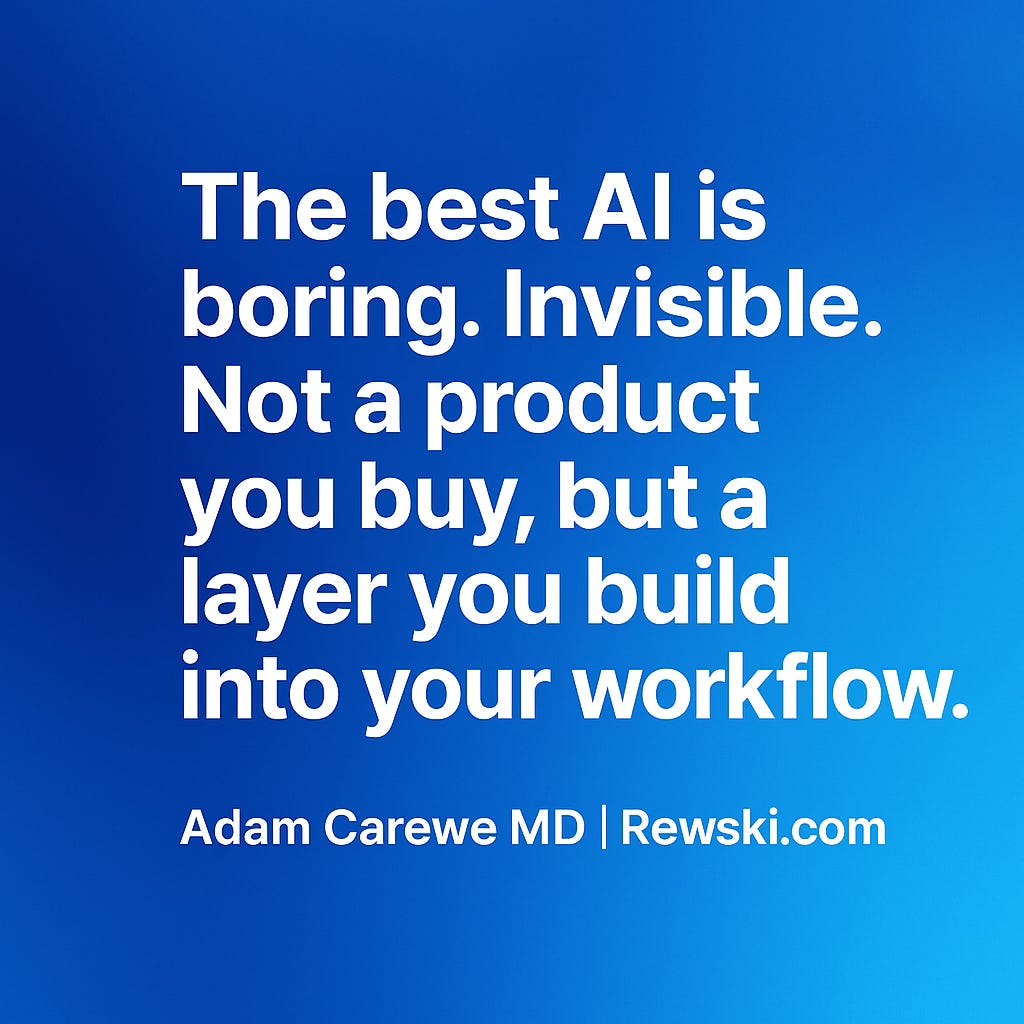Why I Don’t Need Ambient AI Anymore
From Chief Medical Informatics Officer to Chief Workflow Hacker: Why I Built My Own Ambient AI
Want to support Rewskidotcom Substack and the NerdMDs | Efficiency Unlocked Podcast?
♻️ Share this post with friends in healthcare!
🫰 Become a paid subscriber!
📢 Become a sponsor (email me)
🌟 Leave a 5-star review for the NerdMDs | Efficiency Unlocked Podcast
With Epic UGM kicking off this week—and all the swirl about ambient AI—I wanted to pull back the curtain on what I’ve been building for the past year. The headline might sound dramatic, but it’s a little misleading: I still use ambient AI every day. I’ve just stopped using healthcare-specific vendor-provided ambient AI.
This week also marks the one-year anniversary of leaving my role as CMIO of the Colorado region at Kaiser Permanente to join General Medicine while it was still in stealth last August. That shift gave me the freedom to design the tools I’d always wanted but never found in the market.
When the tool you’ve been waiting for doesn’t exist, you stop waiting. And you build it yourself.
I’ve been ambient AI’s biggest fan and one of its critics.
I used Abridge extensively. Nabla too. I even took a role last year as U.S.-based Chief Medical Officer at Heidi Health—because I believed in what they were building and what this space could offer.
I also helped roll out Abridge enterprise-wide at Kaiser Permanente. The feedback was glowing. Ambient AI clearly has real utility.
But none of it stuck for how I practice today.
Here’s why I walked away from ambient AI (as a buyer)
Most ambient AI is optimized for a generic workflow.
Record audio → transcribe → auto-generate SOAP note → drop it in your EHR.
But generating a simple SOAP note isn’t enough—even in ambulatory medicine.
Once you factor in async workflows, multiple care team members, longitudinal context, and structured data inputs, the cracks show quickly.
Plenty of vendors offer templates to massage the output, but even that isn’t specific enough for healthcare’s deeply embedded workflows—rooted in unique combinations of software, team roles, and specialty-specific knowledge bases.
And as we move into a more tech-enabled ambulatory world, that complexity only grows.
The number of edge cases and non-linear workflows increases, not decreases. These tools—good as they are—struggle to truly integrate into that evolving ecosystem.
Again, I don’t blame them.
Most vendors are wrapping OpenAI / Frontier models and bolting them onto EMRs. They're selling into large systems with glacial decision-making and brittle infrastructure.
They're solving the wrong problem for the wrong buyer.
So I built in on my own
We weren’t trying to outcompete the incumbents.
We just needed tooling that fit us.
What I built supports:
• real-time loops between async + live care
• context-aware summarization across messages, labs, and notes
• Synthesizing pre-visit content with conversational content and actionable clinical decision support.
• outputs designed for team workflows, not solo charting
This wasn’t ambient AI in the traditional sense.
This was ambient cognition, wired into how we deliver care.
Once we had that…we no longer needed the traditional ambient vendors.
Will anyone survive?
I still want this space to succeed.
I left a job to help build in it. The problems are real. The mission matters.
But I worry.
Epic UGM is around the corner this week. If Epic announces a native or semi-native ambient offering, it may be game over for many of the startups.
When your core product is a wrapper on someone else’s model, and you can’t own deep integration…you’re one platform shift away from irrelevance.
The deeper lesson
The best AI doesn’t look like AI.
It looks like speed, clarity, and confidence in your clinical flow.
I’d say the same for patient and consumer-facing AI. It should also be invisible but feel magical.
We didn’t need just ambient AI.
We needed ambient systems thinking, tailored to the way we care for patients.
So we stopped shopping.
And started building.
The future of clinical tooling isn’t “Which vendor should I pick?”
It’s: “How can I make my workflow natively intelligent?”
Would love to hear what others are seeing—especially heading into Epic UGM next week 👇
📢 Call to action
Drop a comment, share your tech stack, or tell me I’m wrong.
Let’s keep building smarter systems, not just shinier interfaces.




Interesting. Thanks for sharing your inside perspective